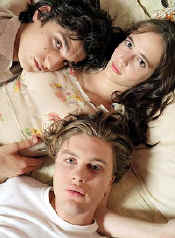By: debbie lynn elias

Paris 1968 serves as the backdrop to this latest entry by Bernardo Bertolucci. Two films in one, “The Dreamers” pays homage to both the French film and the American musical while telling the tale of three young cinephiles bound together by their passion for film. American student, Matthew, travels to Paris as part of an exchange program and finds himself befriended by French twins, Isabelle and Theo, who he meets in the Cinematheque as the three are enrapt with a Nicholas Ray film that’s screening. Bertolucci immediately sets the tone as he captures the imagery of the black and white celluloid reflecting on the wide-eyed faces of the movie-goers. Enraged by the firing of Henri Langlois, director of the Cinematheque Francaise, the three become embroiled in the student riots of ‘68 beginning with a protest to reinstate Langlois set to a soundtrack of Francois Truffaut’s empassioned protests. (The protest did work. Langlois was reinstated.)
Isabelle takes a shine to the young Matthew and invites him to her parents home for dinner. Her father, George, is a renowned author while her mother is a Bohemian intellect. Disrespecting the parents, Matthew finds himself ensconced in the hearts of Isabelle and Theo and he soon finds himself moving into their palatial apartment (hey, anything is palatial after a shabby Paris hotel) for the summer while the parents are away. But Matthew gets more than he bargained for when thrust into the rather free, bordering on incestuous, lifestyle of the twins. You’ve heard of Truth or Dare? Well, how about Truth or Dare movie trivia with sexual repercussions? And don’t even ask about what goes on in the kitchen. It’s definitely more than cooking. And is there a water shortage in Paris? That seems the only logical explanation for all three of them sharing a bath. In other words, you get my drift…..
What is interesting is the conversation that carries throughout the film. It is truly a lost art and Bertolucci brings it back to life with our three principals as they sequester themselves in the apartment, carrying on countless debates over the cinema (and the arts) while perched underneath posters of Jean-Luc Goddard. Keaton versus Chaplin. Joplin v. Hendrix. Conversation carries on even through the sexual encounters giving an even deeper feeling of the power of film and setting the stage for the political climate of the day and the frivolousness of sexuality. Strains of Janis Joplin are even heard playing in the background. Jean Rabasse’s production design beautifully facilitates the conversational aspects, providing a layout of a Parisian apartment that allows the characters to see each other at all times separated only by a spectacular inner courtyard.
Despite the inherent sexuality (but of course, it’s Bertolucci, what did you expect!), the film is expertly and exquisitely crafted conveying a love for film that is superior to the love or lust of human beings. Intertwined with the story of three is a story of cinema which is eloquently told thanks to the editing of Jacopo Quadri. As homage to the 9 minute marathon run through the Louvre in Goddard’s “Bande A Part,” Isabelle challenges Theo and Matt to best that record and the three take off on their own marathon which is intercut with the original film sequence. Quadri evokes a seriousness, a sensuality and a beauteous flow as he merges the real with the surreal. Equally as beautiful, if not hysterically funny, is a montage of Isabelle mimicking Greta Garbo in “Queen Christina” but with her own unique twist to the bedroom scene.
Bertolucci takes an interesting turn with his characters, mirroring each of them and their relationships and reactions to life based on film. With little awareness but for what they have absorbed through film, our principals echo the characters they know and mimic the scenes and situations they embrace. And again, capitalizing on this, Bertolucci pays homage to “Les Enfantes Terribles” and “Jules and Jim” with the somewhat twisted sexual scenarios.
As for the individual characters, Louis Garrel and Eva Green are ideal as the spoiled and twistedly incestuous twins, Theo and Isabelle. Completely noxious and unlikeable, yet fascinating, Garrel brings a brooding to Theo that is a perfect compliment to Green’s effervescent Eva. These two have an ability to draw you into the story and the characters with a “don’t look”, but “you must look” energy. Michael Pitt who was annoyingly mealy-mouthed and demented in “Murder By Numbers” is little different here as our sole American, Matthew, and appears as if a poor man’s version of Leonardo DiCaprio. He mumbles and stumbles his way through, never quite convincing the viewer he’s as naive as he seems. Younger maybe, but not naive.
Some thirty years since “Last Tango in Paris”, Bertolucci proves that he is still at the top of his game. Although the story falls apart in places and has some twists that are inserted only as a means to an end, Bertolucci still has the ability to draw you in and use sexuality as a form of art. His work is, as always, captivating, open and frank. Sadly, however, here the story itself falls short of the cinematic history which it honors.
Matthew: Michael Pitt Theo: Louis Garrel Isabelle: Eva Green
Directed by Bernardo Bertolucci. Written by Gilbert Adair. Rated NC-17. (116 min)












